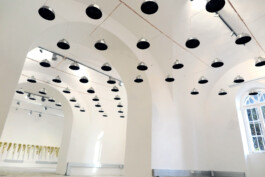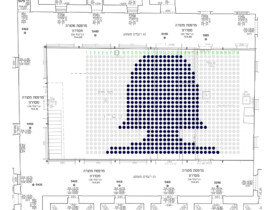PEOPLE YOU MAY KNOW | SOLO EXHIBITION
Hansen House, Jerusalem, Israel | 2014
Curator: Karni Barzilay
Wrote about the exhibition:
Liat Segal's first solo exhibition observes self-identity and representations through social media. Four installations light up questions of personal dimensions in a technological era and the relationship between human and mechanical behavior.










The way we consume knowledge and information about people around us has changed. Our technological reality has created a distance from the human-personal experience, translated into algorithms, codes, shapes, and is more mediated than ever. Liat Segal's first solo exhibition deals with the relationship between the human and the technological, as well as the way the self is represented in social media. The exhibition consists of four installations that light up the question of a personal dimension in a technological environment and the relationship between human and mechanical behavior.
The title of the exhibition – People You May Know is drawn from Facebook's suggestion to its users, to connect with other users to expand their circle of friends. As a rhizomatic data mechanism operating by the principle of interpersonal connections expansion, this Facebook suggestion raises questions about the types of relationships and our identity's definition within digital media. Segal's quest for the possibility of personal identity, personalization, and intimacy to exist on the internet, has led her to use the Facebook platform as a case study as well as a field of study from which she samples data for her works.
The sound installation People You May Know consists of a collection of audio speakers hanging in the gallery space. Each playing monologues are taken from the personal Facebook profiles of the artist's friends. These sentences that she reads, using the first person form, are personal and revealing. Segal creates a new identity, composed of multiple voices and narratives sampled from Facebook.
The voice moves in space in a way that is determined by an algorithm that chooses the movement course in real-time, it creates a sense of a speaker walking in the gallery. Although the voice lacks body or identity, it does have a location in space, which is represented in the work Location 2.0 exhibited in the adjacent space. Using shining objects that are originally used as a survival rescue blanket to maintain body temperature, this work follows the coordinates of the voice movement in space. The objects hanging on the wall are inflated in accordance with an x-y axis system while pointing to the location of the voice in space. Although Segal uses a mathematical model that supposedly represents the world, the model's physical expression is very much momentary, made of air.
In the installation Writing Machine, a computerized machine is drawing with a paintbrush and water on a plaster surface lying on the gallery floor. Repeatedly and endlessly, the machine scribbles names taken from the artist's list of virtual friends. One by one, the names are written down on the plaster surface and then erased (evaporated). The act of drawing makes some of the individual identities present for a moment within the masses while revealing an additional layer to Segal's entire process in this exhibition – the destruction and reconstruction of identity representations. With time, the surface gets forever scarred by the water and brush strokes.
The mass of cylinders, installation Placeholder at the Hansen House patio presents a coded image – the well-known Facebook face icon. This image is made of a surface covered with roll-shaped bodies, originally used as a cosmetics product packages, dark on one side and silver on the other. Together, they create an entire image, a sort of material translation of pixels, where in one particular moment and location of the spectator's sight, this translation consolidates into a generic face. The well-known face icon represents the moment when we join Facebook, the first step of identity construction in it. That very "determining moment" when we change this generic image into our own profile picture poses a question: Have we turned from an icon into a private person, or are we just another statistic in the virtual space?


Segal's scientific background inspired People You May Know. More of her science-driven works include Random Walk, FOMO, and Tropism.